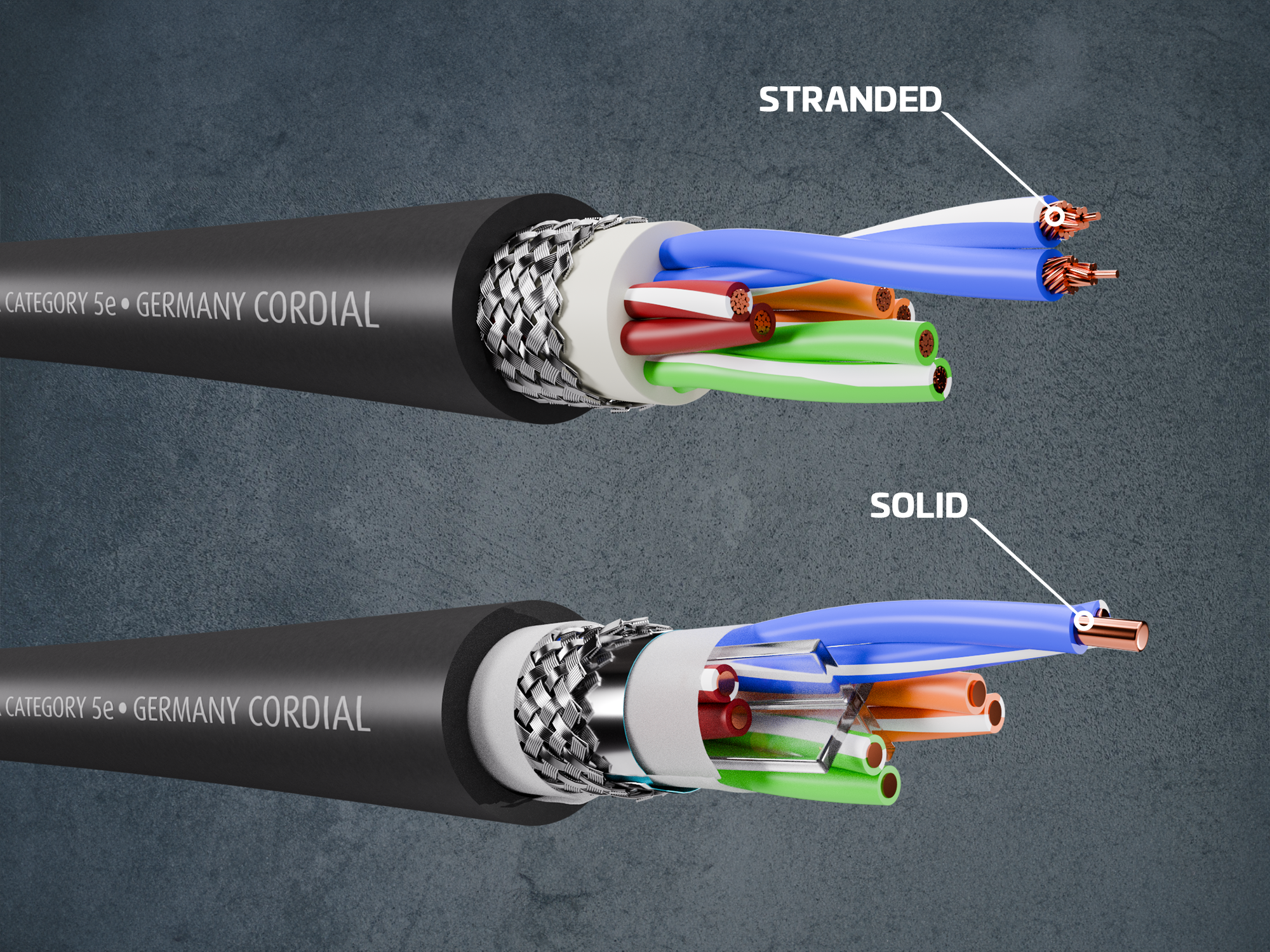
Conductor type - influence on signal transmission
The selected type of conductor is a decisive factor regarding signal transmission within a cable.
You have to distinguish between two types of conductors:
- Stranded: multiple strands
- Solid: one strand
In multi-wire conductors, several insulated cores are arranged next to each other in a cable sheath and enclosed in a flexible outer jacket. In contrast, solid cables consist of a single conductor, which is normally surrounded by insulation.
Both types of conductor have certain advantages and disadvantages when it comes to their properties and the way they are manufactured. Based on these criteria you have to decide which cable is best suited for the respective application.

Multi-wire conductor (stranded):
Advantages:
- they are relatively flexible and thus very suitable for stage use, for example
- they can also be used as patch cables, for instance
- they can easily be reeled
- they are enormously versatile
Disadvantages:
- comparatively, they are more expensive
- they generally have a shorter range
- they are relatively more susceptible to interference
Conductors with one strand (solid):
Advantages:
- they perform very well over long distances
- they are relatively inexpensive
- they are particularly suitable for fixed installations due to their high stability
Disadvantages:
- they are less flexible and harder to reel
- there is a risk of cable breakage with regard to constant movement
When it comes to selecting the appropriate type of conductor, it is therefore important to consider carefully what to focus on regarding the respective application.
This relates especially to the following factors:
- Flexibility:
- Solid (one strand): Solid conductors are generally less flexible than multi-stranded conductors. They are better suited for fixed installations where the cables do not need to be moved or bent frequently.
- Multiple strands (multi-wire): Multi-wire conductors are more flexible and better suited to applications that require frequent cable movements or bending. Consequently, they are predestined for applications where greater flexibility is required and can also perfectly be used as patch cables.
- Longer distances:
- Solid (one strand): In principle, solid conductors offer comparatively excellent signal integrity over long distances and therefore perform better than other types (they are, however, relatively more susceptible to interference over shorter distances due to the closer proximity of the inner conductor to the external environment).
- Multiple strands (multi-wire): The structural design of multi-stranded conductors minimizes the risk of electromagnetic interference and crosstalk over shorter distances, as the individual conductors are separated from each other within a cable. Over very long distances, however, a cable featuring multiple strands can lose some of its efficiency due to its higher sensitivity to electromagnetic interference (EMC) compared to solid conductors.
- Type of installation:
- Solid (one strand): Solid (one strand): Solid conductors are, on the one hand, relatively more stable, but, on the other, more susceptible to constant movements. They are therefore more frequently used in fixed installations (e.g. laid in walls or ceilings) than in mobile environments.
- Multiple strands (multi-wire): Due to their high flexibility and excellent reeling properties, multi-core conductors provide a good solution for mobile use (stages, tours, festivals, etc.) as well as for a connection between mobile devices (patch cables) - see above.
- Costs:
- Solid (eine Litze): Solid (one strand): Particularly suited for use over longer distances, solid cables can be a more economical option than multi-core types due to their lower production costs.
- Mehrfach-Litzen (mehradrig): Multi-strand (multi-core): Multi-stranded cables can be slightly more expensive due to the more complex manufacturing process, but are more flexible and versatile.
Please note: selecting the correct cable for an application requires the careful assessment of a variety of factors including AWG ratings, shielding, insulation, cable length, data class and respective application. It is crucial to take into account all factors relevant to the specific application to ensure signal integrity and the optimum system performance.
Further interesting "Cordial Knowledge" facts on the subject:
AWG - Influence on signal transmission